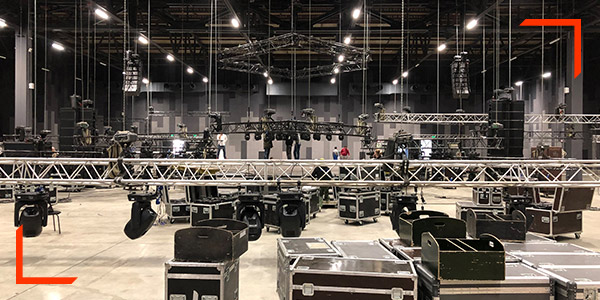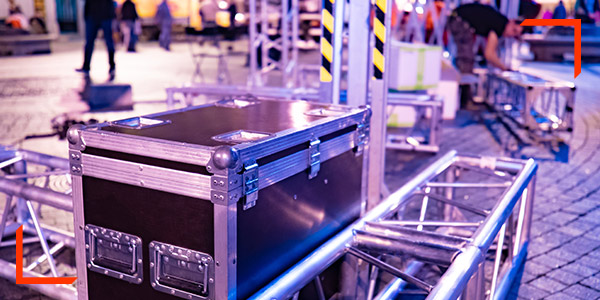Covid-19 Secure guidance for the operation of stage equipment
Audio equipment susceptible to viral contamination is often items used near the user’s face.
These items can be microphones, handheld cameras, communications headsets, and other devices handled by artists and crew. This can also include any item that may be contaminated through attachment to an instrument or device, such as a microphone clipped to the end of a wind instrument.
Given that the transmission paths of the Coronavirus is from aerosol (coughs and sneezes) and touch from contaminated surfaces, the likelihood of virus transmission in the use of sound equipment is high due to the way in which audio equipment is used and shared.

1) Is the equipment you receive safe?
Do you know that the equipment you are about to use is free from pathogens? Has it been treated since its last use?
If you cannot confirm that either around one full week in total isolation has passed since last use (Sterilisation over time) then the equipment should be cleaned and sterilised before handling and use.
2) Is the equipment likely to be handled close to the face, or used by more than one person?
If yes, then it cannot assume that the users are free from infection or contamination (symptoms can be mild, varying, or not visible at all, yet the person can be contagious and a vector or the virus).
Any equipment used by multiple users (including technical set-up teams) should be cleaned and sterilised between users, without exception.
3) Are people likely to share microphones or communications equipment during the event?
If yes, this must not be allowed. Not even just passing a used mic to a random member of the technical crew
If an item cannot be effectively cleaned and sterilised between users, shared use must not be allowed. Microphones must not be passed from artist to artist, or technician to technician, it must be assumed that the last user could be contaminated and adjust procedures accordingly.
Items used near the face, respiratory path and eyes must be designated to one user only during an event, unless it can be cleaned and sterilised between users.
4) What happens to the equipment after use?
Usually there is a rush to get home after the event, equipment is typically put away and returned to storage immediately. This unsafe approach can no longer be taken.
There can be only two options, either all potentially contaminated items are cleaned and sterilised on site before being removed from use, or all potentially contaminated items are quarantined and labelled as contaminated and kept in some form of isolation (within a clearly labelled designated case or bag specifically labelled as contaminated – Danger Bio-Hazard! ).
There must be an organised procedure of what crew do with used comms, do not just leave it about where you were working at the end of the show for anyone else to handle (they won’t know if it is clean or contaminated), return comms or similar personal equipment yourself to a point where it can be properly processed without risk of cross contamination and stored safely
Quarantined items can then be sterilised at a later stage or left in quarantine for adequate time for the pathogens to die (relative to published timescales, typically a minimum of 72 hours).
 5) What about people handling the items?
5) What about people handling the items?
It is not simply enough to protect the person using the equipment, the people handling the equipment must also be kept safe. Equipment must be treated as biohazardous when handled and when used near a user’s face.
Any person handling the equipment must do so as though it is contaminated, use gloves, wash hands, and immediately clean and sterilise or quarantine that equipment so it cannot be handled by others unknowingly. Items such as tops of microphone stands, mic clips, and user ends of microphone cables (female connector end) should be wiped down with an effective proven disinfectant (not alcohol).
6) Consideration should be taken to use of shared equipment.
Shared Equipment like DJ equipment where potentially infected users are in long term frequent contact with surfaces that can be potentially contaminated, particularly when the user may be physically active in their performance and of elevated levels of breathing directly over the equipment.
If, as in many cases, the operator or performer may be constantly touching the control surface and then their face it should be considered to sterilise the equipment between users, maybe by having two sets of equipment, a method of cleaning and sterilising the equipment while in use, or a method of using another source of sound while the equipment is being processed.
7) Any method of sterilisation must be proven to be effective.
Effectivity must be assured either by following scientifically proven practice, or by using scientifically proven calculations to ensure more than the adequate dose of exposure to effective sterilisation methods. Adequate risk assessments must be carried out to identify correct methods of decontamination, effective in the workplace.
It must be assured that the sterilisation method is carried out correctly in accordance with effective procedures or manufacturers recommendations. and measures are in place to ensure process mistakes, or partial processing, is all but impossible
Any substance or equipment that sterilises the items must be verified to be suitable for use on items such as those being processed. If in doubt consult the manufacturer for clarification. Putting a radio mic or headset on a tray for casually surface sterilising mobile phones is highly questionable as an effective treatment, as is quickly wiping it with a known ineffective solution (such as 98% alcohol) A partially treated item is worse than having no process at all. You MUST know that an adequate, effective, dose of treatment is being applied, and you MUST be able to prove you have reasonably within your abilities assessed that method.
Care must be taken to ensure that the complex nature of items like microphone heads is factored into the dose calculation used. DO not use substances that can evaporate faster than the time required to effectively kill the pathogens. If applying substances to the surface of equipment it MUST be assured that the application method provides total coverage in an effective manner, even in small detailed parts likely to contact the user.
8) Are your operations adequately planned?
Plan all safety operations before the event and brief the users on the new protocols. It is not sufficient to simply have a regime in place.
If nobody knows correct procedures exist or knows they must modify their way of working they are going to do what they always did. Until people are accustomed to not sharing items that they place in their respiratory path with others they will continue to perform in the way they always have.
You would not share cups or knives and forks with other diners in a restaurant, yet that is the same degree of cross-contamination the event industry has been exposing staff to for decades with microphones.
Up until now it has been accepted that microphones that have been in contact with someone’s breath and touching, or close to a performers face, and that has frequently touched by their lips is then passed, uncleaned, to another performer for them to do the same. It has become widely and wrongly accepted in the rush of the show, and in the interests of cost, that users unknown to each-other will use and share unsanitary equipment (obviously they do not think about what they are doing) This cannot be deemed to be safe at any time, less so during a viral pandemic.
It is time, in the light of a global pandemic to cease this unsanitary practice. It may however take a degree of effort to change everyone’s way of working to accommodate this change. This will need to start at the production meeting stage to ensure that correct scheduling of the process is permitted. And everybody informed. It is too late when the show is on to suddenly say “wait a minute while I clean this for you”, especially if an artist or the item is in full public view when deemed to be in need of intervention. Proper planning and communication are essential to keep everyone safe.
 9) Who is using equipment that is likely to infect them or others?
9) Who is using equipment that is likely to infect them or others?
It is not just the performers, or singers. Many of the production team will use head-mounted microphones, body-worn walkie-talkies, or other items near their breathing zone and face.
Often, the microphone of communications equipment must be used super-close to the mouth as they are either working in a loud environment, or the opposite, where they must talk quietly to not disturb the show yet be heard on the comms.
It is the most serious responsibility of the employer and production management is to ensure the health and safety of all staff, and that anyone using the equipment is not compromised. It is a legal requirement for employers to carry out a suitable and sufficient risk assessment and determine what can be done to manage the significant risks identified. This includes exposure to infectious diseases such as coronavirus.
10) Vulnerable individuals and cases requiring greater care.
Measures should be enhanced where the performers, or staff are more vulnerable to severe reactions to infection, such as people with respiratory or immune weakness or increased age. While it is not acceptable to put anyone at risk, extra care must be taken when working with older or weaker colleagues or clients.
While it may be very unpleasant, likely to cause a loss of work over the period of illness, and increased risk of further infecting others, in most cases a physically fit person being infected with a pathogen will be a mild to medium short-term illness. IT is very easy to slip into he mentality of “well it’s not really that serious for me and my team”. However, statistically with either Covid-19 or seasonal flu, people with weaknesses and increased age are significantly more likely to die or have long term issues from infection or complications.
Covid-19 aside, any respiratory infection can potentially have severe consequences to a professional singer, having to be surgically intubated through contracting Covid-19 or any other severe throat infection would run a high risk of potentially never being able to sing again. It is no minor issue. It can be life-changing if not deadly.
it has been common and well known for professional singers to be out of work through oral or respiratory infections, an unknown quantity of which could easily have been contracted through contaminated microphones. Microphone hygiene is very important and has been negligently ignored over many decades by many parts of the event industry. We must stop this unsanitary practice now. A little extra care with handling of devices that are in the direct respiratory path of the user may well make all the difference. More so, as a employer, manager, or competent worker you have a legal duty to ensure you work in a safe manner.
References
HASWA 1974 sections 2 & 3
Provision and Use of Work Equipment Regulations
Control of Substances Hazardous to Health
Workplace health, safety, and welfare. Workplace (Health, Safety and Welfare) Regulations 1992
Regulation 5 Maintenance of workplace, and of equipment, devices, and systems Regulation 9 Cleanliness and waste materials



